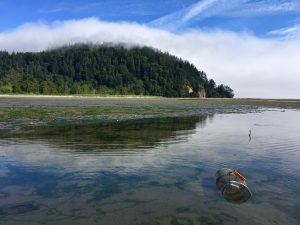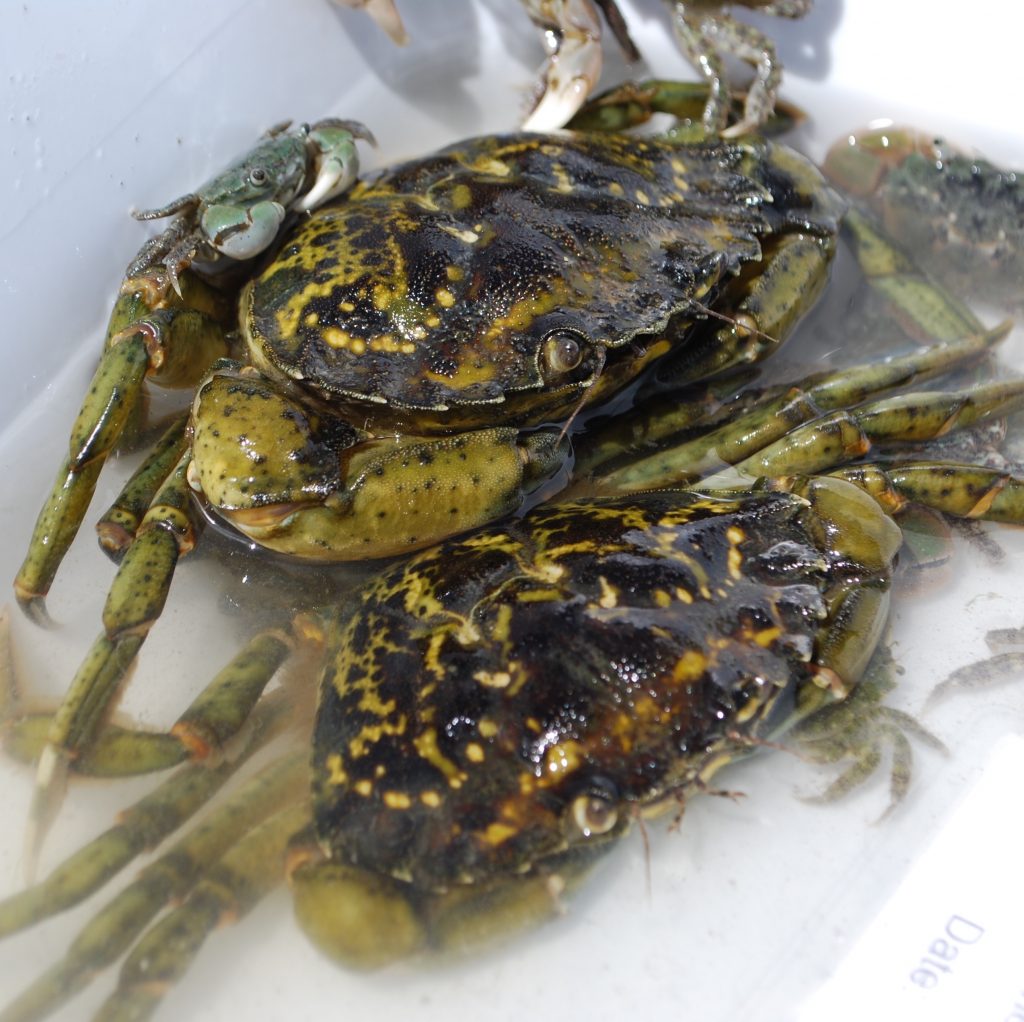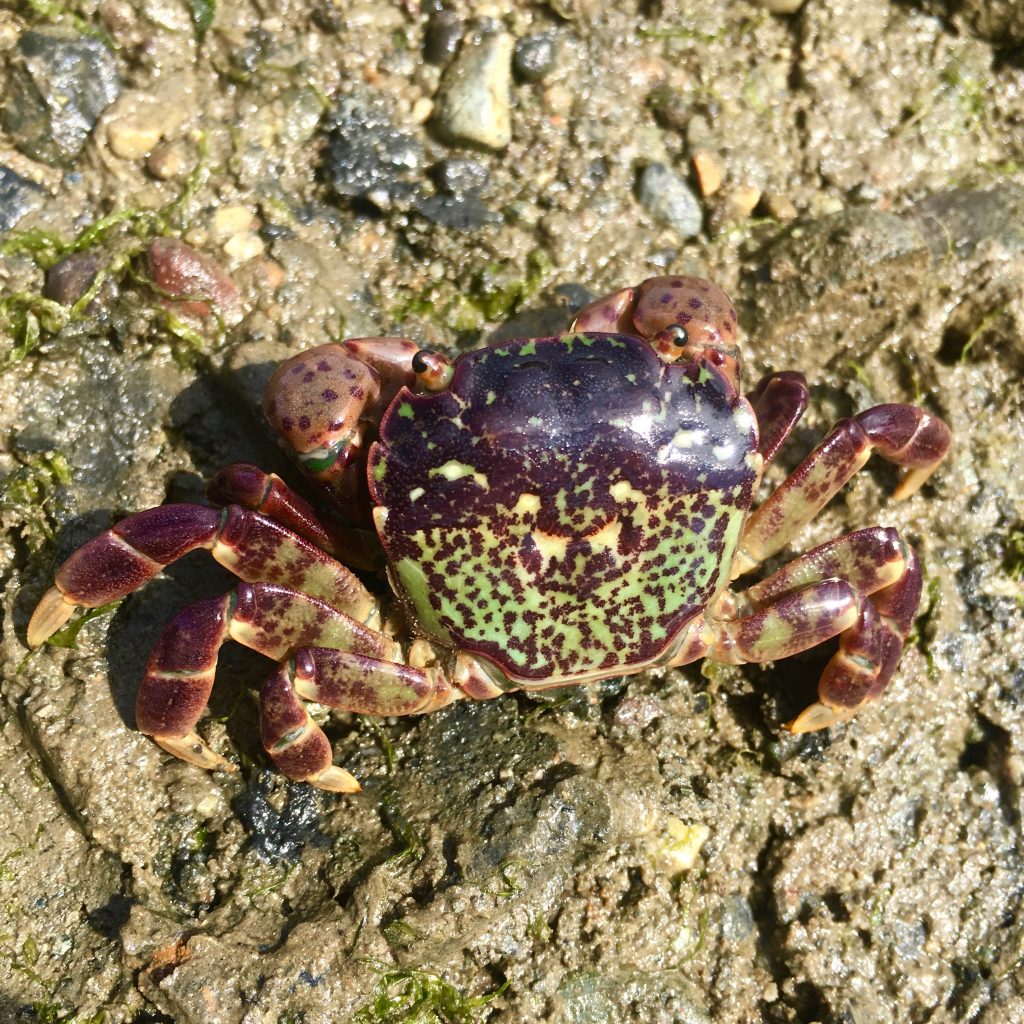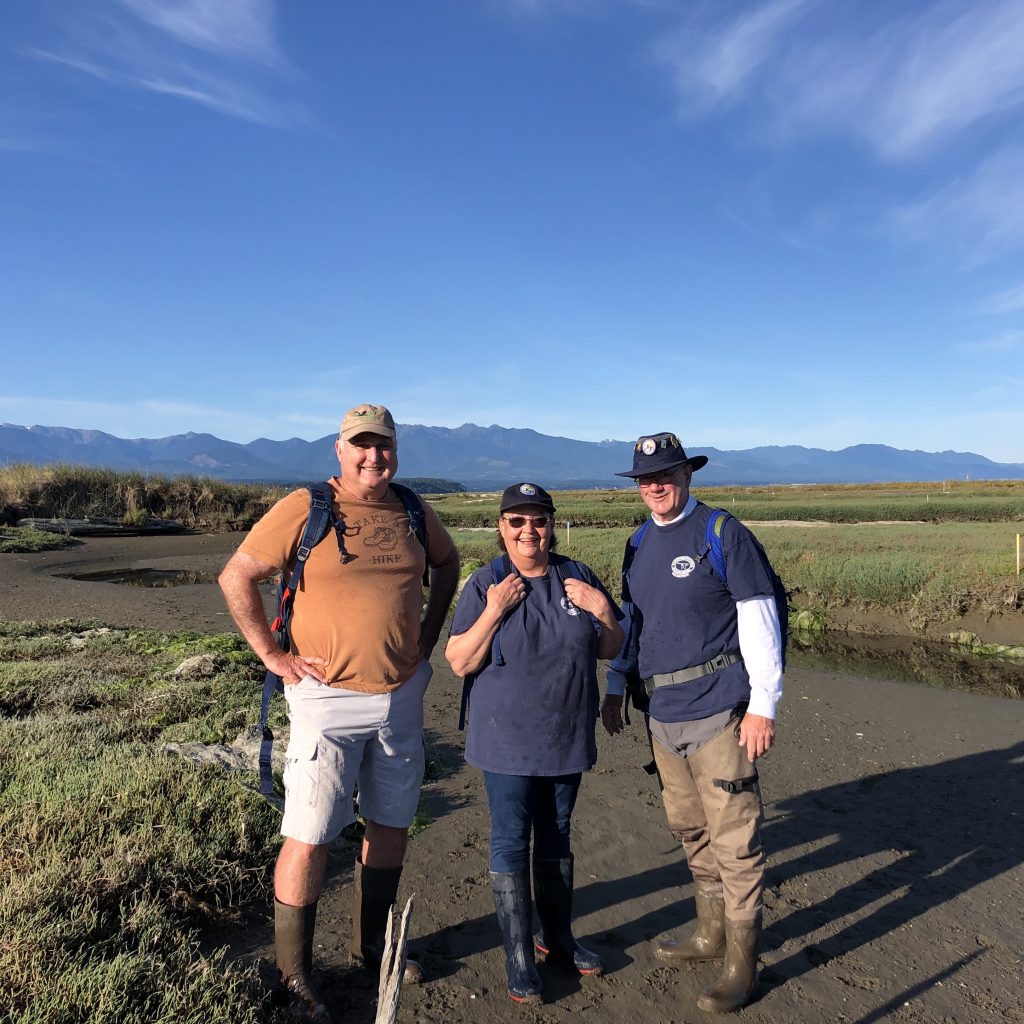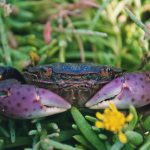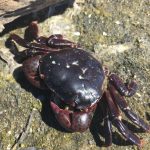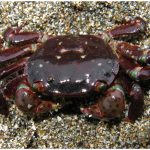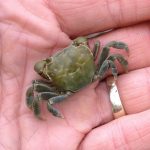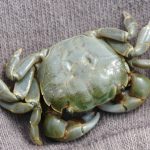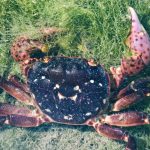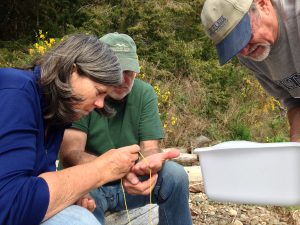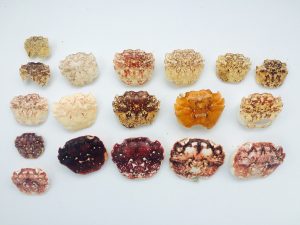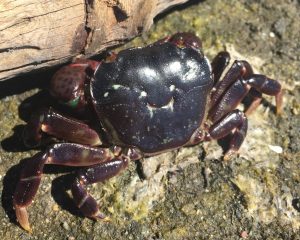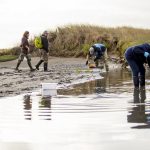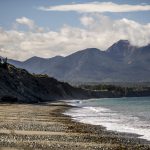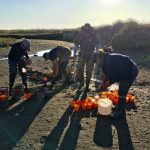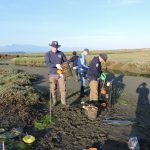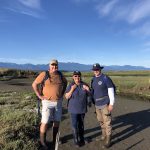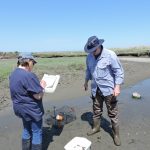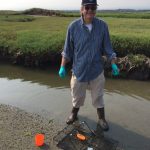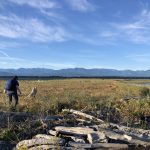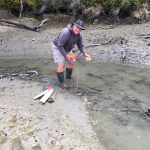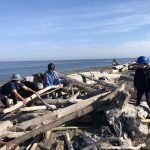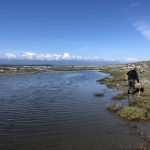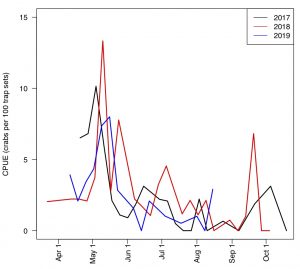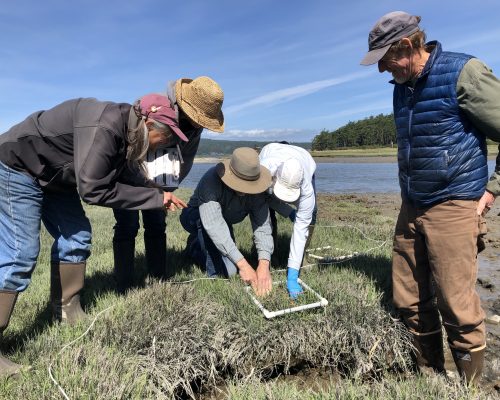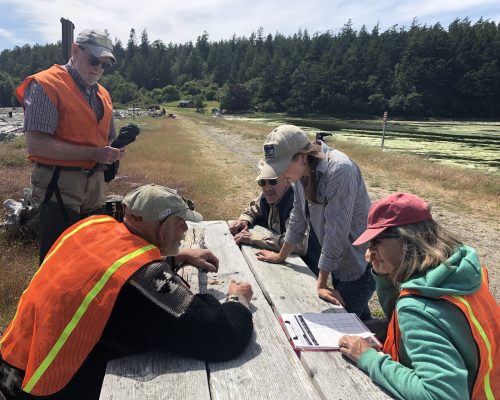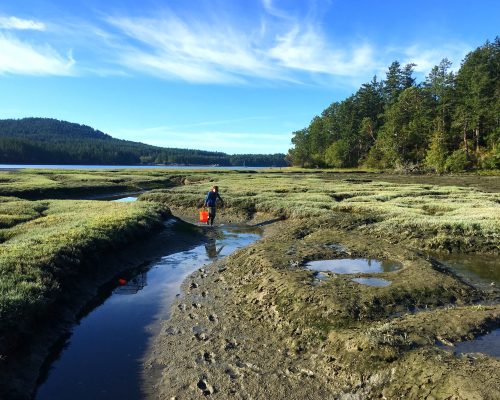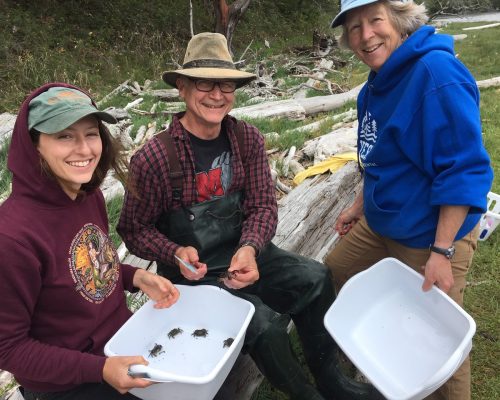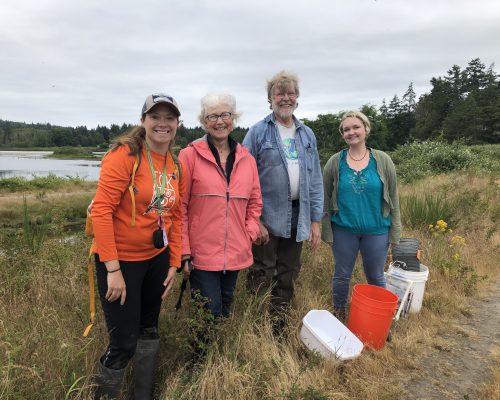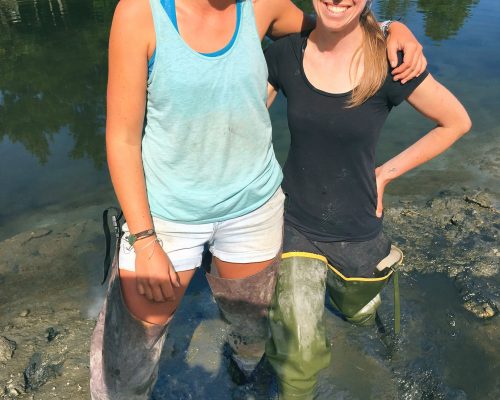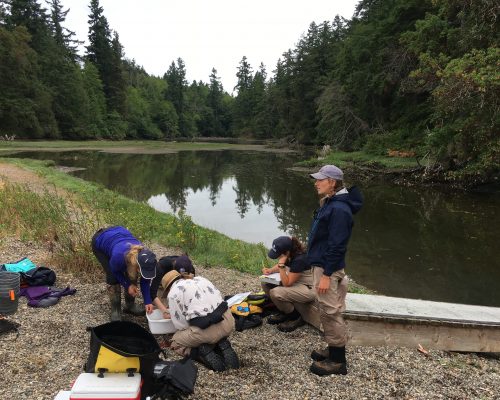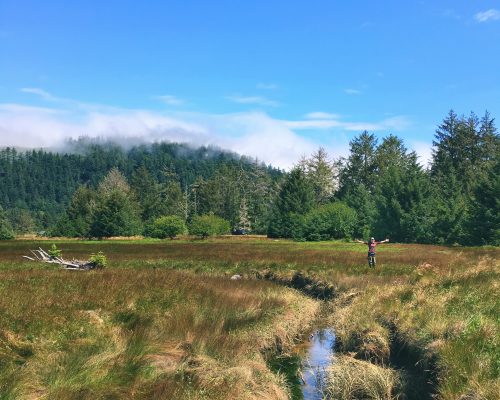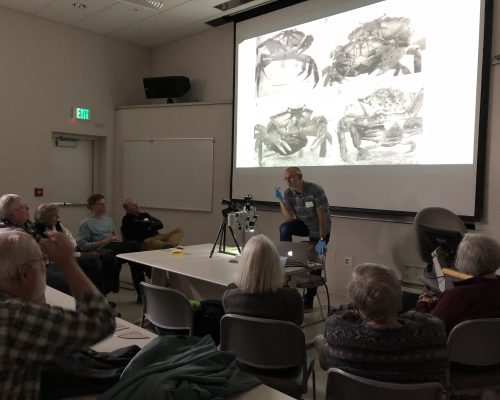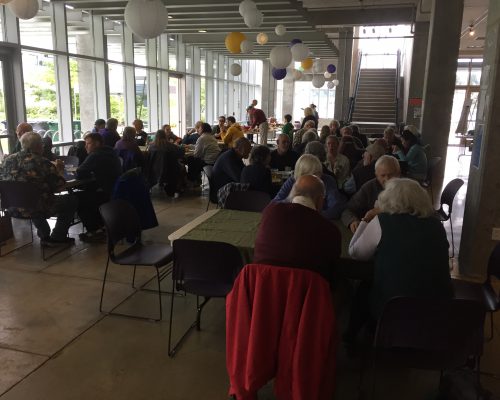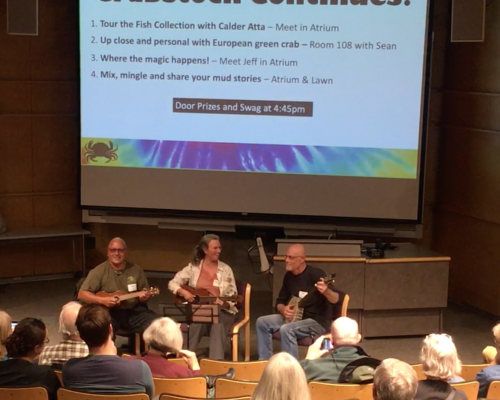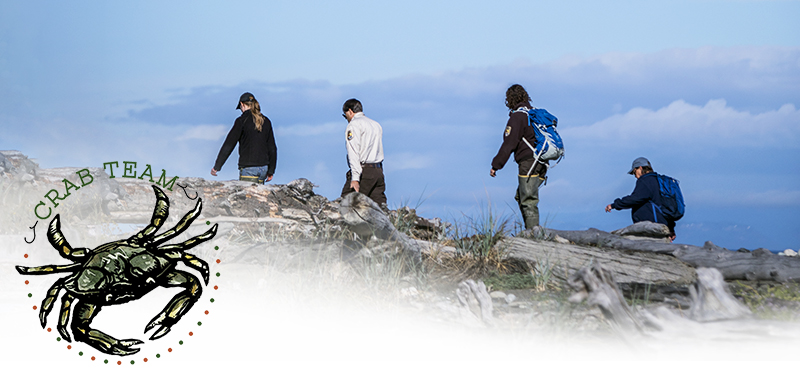
Recipe for Successful Management
November, 2019
We’re often asked if you can eat green crabs, and whether that is a key to managing them. Green crabs are edible, but thankfully, we don’t currently have anywhere near the number of crabs on inland shorelines that would sustain a fishery, and we hope to keep it that way. On the U.S. East Coast, folks are working very hard to make a market for the species as a way to reduce their ecological impacts. Because every invasion is different, for the current situation in the Salish Sea, our recipe for success could have different ingredients.
In September, we celebrated with volunteers at our first Crabstock, an event five years in the making to offer appreciation to those who have built the foundation for effective management of European green crab along Washington’s inland shorelines. We invited volunteers to show up hungry for hamburgers and thirsty for green crab knowledge on the University of Washington campus. The event was a great chance to share our muddiest stories, and to celebrate all of the contributions people have made to tackling this regional threat — including the artistic contributions of The Mudsuckers of Lopez Island, who debuted their song “Green Crabs ‘A Comin’!”
Unfortunately, the 2019 sampling season ended with finding a concerning number of green crab at a new site near the Canadian Border, having been first detected as molts by Crab Team volunteers. But as the list of sites where green crabs have been found within the Salish Sea has grown over the past three years, so has the awareness of the threat green crab poses, the experience level of the managers and Crab Team volunteers who respond, and the partnerships and collaborations that can facilitate effective management. We have ingredients for successful protection of the Salish Sea shorelines. Now it’s time to get into the kitchen and cook!
All our pinchy best,
Crab Team HQ
 Green Crab: Can They Smell?
Green Crab: Can They Smell?
Chances are you’ve never heard of pheromones. Yet these chemical compounds are profoundly important. They’re even the basis for what we think of as attraction — after all, how many times have you heard about couples who have “great chemistry”? But pheromones do much more than kindle romance, and they are quite common throughout the animal kingdom. In fact, pheromones are any chemical substance released into the environment by an animal that affect the behavior or physiology of others of its kind. While best known for their impact on animal mating, pheromones are also responsible for communication among colony-forming insects, influencing feeding behaviors and delineating territories, and even bonding between mothers and infants.
The Birds and the Bees, and the Crabs
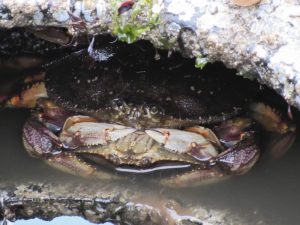
These two Dungeness crabs (Cancer (Metacarcinus) magister) are showing the mating posture, with the male clasping the female underneath him. The crabs will mate face to face, but he may carry the female around right side up prior to and following mating. Photo: Jeff Adams
The ancient Greeks were among the first to recognize that animals secrete substances to attract mates, and by the 19thcentury, entomologists were familiar with the ways in which bees, moths and ants seemed to communicate using odors. By contrast, it wasn’t until the mid-1960’s that pheromones were identified in crabs (Ryan 1966**), and the chemical nature of these substances has only recently been explored and synthesized, owing in part to difficulties in purifying pheromones from seawater (Hardege et al. 2011). Over the past two decades, research on crab pheromones has focused on their role in mating, and much of this research has been conducted on European green crab, Carcinus maenas. Because mating in green crabs is synchronized with female molting, sex pheromones are critical for ensuring that receptive partners find each other at the right time.
Timing is everything when it comes to green crab reproduction. That’s because female reproductive organs are only accessible to males immediately following the molt and before the new shell hardens. When a male detects a receptive female, he grasps and positions her beneath his abdomen, placing her in a cradle position, thereby guarding her from other suitors. The male will continue to cradle the female throughout mating, only releasing her once the new shell hardens and she is no longer vulnerable to predators or receptive to the advances of other males in the area (Berrill & Arsenault 1982). Pheromones allow male crabs to sense and select pre-molt females as they approach their critical reproductive period.
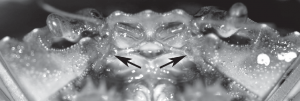
Magnified view of the face of a green crab, the arrows point to the nephropores, the paired openings where urine is released. Photo from Ekerholm et al. 2005.
Female crabs nearing their molt release sex pheromone in their urine, which emanates from the antennal gland between the eyes (Eales 1973). While this design might seem maladaptive, peeing out of one’s own face has advantages, in that urine is carried away from the body in respiratory currents and flow can be directed for maximum effect during face-to-face encounters. The pheromone, which is known by the chemical name, uridine diphosphate, is detected by the males’ antennules and induces a suite of behaviors in male crabs, including increased antennule flicking, searching, pre- and post-mating guarding of the female, and initiation of mating (Bamber & Naylor 1996; Hardege et al. 2011).
In addition to making females more attractive to male crabs, the sex pheromone makes males more aggressive toward one another. Researchers at the University of Glasgow in Scotland found that male green crabs fight each other more intensely and for longer duration when exposed to female sex pheromones. Moreover, these altercations often result in physical injuries (Sneddon et al. 2003) with long-term consequences. For instance, the loser of a fight subsequently shows a delayed and muted response when exposed to female sex pheromones (Fletcher & Hardege 2009).
While female sex pheromone is arguably the most important pheromone for mating, it’s not the only one involved in reproduction. Researchers from Cardiff University in Wales demonstrated that the hormone crustecdysone, which is produced by the female crab during molting, also acts as an appetite suppressant for male crabs in laboratory experiments. This signaling hormone would seem to act as an insurance policy for the soft-bodied and extremely vulnerable female by reducing the risk of cannibalism (Hayden et al. 2007). Interestingly, this action is sex-specific; feeding by non-molting females is not suppressed and these crabs are just as likely to engage in cannibalism with or without crustecdysone.
What Can Pheromones Do For Us?
Fascinating stuff! But can we capitalize on chemical communication to control green crab populations in the Salish Sea? As it turns out, pheromones have been used widely in agricultural settings for pest management, as well as to control invasive insects. A team of international researchers is investigating using this approach for green crab. Joerg Hardege of the University of Hull, England, and Sylvia Yamada of Oregon State University have conducted tests using a synthetic sex pheromone formulation. Unfortunately, results to date have been mixed; the pheromones don’t seem to be any more effective than traditional (fish) bait and they’re harder to use. “I don’t see pheromones being a magic bullet,” Yamada explains, and efficacy is, “limited to high pH and water temperatures above 15 degrees Celsius.” The practicality of using female sex hormone as a bait might also be limited by its range and what might be termed the “detection sensitivity” of male crabs. Mattias Ekerholm and Eric Hallberg of Lund University in Sweden found that, at low concentrations, the pheromone can be effective over a short distance at eliciting increased search and mating-specific behaviors. However, male crabs aren’t necessarily able to detect and follow a concentration gradient of the pheromone, suggesting males cannot follow the pheromone to its source – presumably a female crab (Ekerholm & Hallberg 2005). It’s akin to hearing a high-pitch sound yet being unable to discern where it’s coming from. Thus, even if a male crab detects a signal emanating from a pheromone-baited trap, it might not be any more likely to enter the trap and be caught.
Despite setbacks using female sex pheromone for control, Yamada isn’t giving up. She and her colleagues are exploring alternative pheromones that may act as deterrents. Yamada can imagine opportunities to combine chemical attractants and deterrents for green crab in the same way these stimuli are combined in push-pull integrated pest management for agriculture. In these approaches, deterrents “push” pests away from protected areas and attractants lure or “pull” them to traps (Cook et al. 2007). Such a combination could conceivably make control programs more effective.
– Sean McDonald
**While we try to use open access sources as often as possible, some of the studies cited in this article are not open access. If you have any questions about any of the research cited here, please feel free to reach out to crabteam@uw.edu.
The mud can be sticky, the crabs can be pinchy, and the tides don’t always align with sunny weather. But if you ask Crab Team volunteers, many of them will say that the most challenging part of Crab Team sampling is distinguishing between our two native shore crab species of the genus Hemigrapsus. Of these two close cousins, we often talk most about H. oregonensis, HEOR, the hairy shore crab, because it is by far more abundant and ubiquitous in our sampling than any other animal, comprising more than 90% of all organisms captured in Crab Team traps.
As crabs go, the purple shore crab, H. nudus, comes in a distant second to the hairy across the Crab Team monitoring network, even though it is probably as abundant and widespread in the Salish Sea. Why is that?
Not Quite Identical Cousins
The two species are indeed visually very similar, and sometimes it takes a well-trained eye to distinguish them. Both have squarish carapaces, rounded claws and measure a maximum of a few inches across the back shell. Similar to many crabs, color can be widely variable: we have found green “purple” shore crabs and hairy shore crabs that are purple in color. As the scientific species name “nudus” suggests, one feature that can help tell the two crabs apart is that the purple shore crab lacks the abundant hairs the hairy shore crab has on its walking legs. But when looking at a molted crab shell, the color can be bleached out and the hairs on the legs can go missing, making these features unreliable diagnostics. Crab Team monitors are trained to look across multiple features, and pick out subtle differences — sometimes needing a magnifying lens — including how far the bumps between the eyes of the crab project, and the direction of the marginal teeth on the edge of the shell. (Learn more: https://wsg.washington.edu/id-flashcards/)
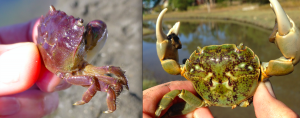
A purple hairy shore crab (left) and a green purple shore crab (right). A great example of why you shouldn’t use color to tell species apart!
If the crabs appear so similar, why do we find so many more hairy shore crabs in our traps? Well if one were to look even more closely at the two species, say, inside their gill chambers, you’d notice another species difference: hairy shore crab have finer setae (hair-like structures) protecting their gills, and more of them than purple shore crabs. The stouter, sparser setae of the purples aren’t as effective at straining tiny silt particles out of the water, so in muddy habitats, their gills can get clogged (Hiatt 1948**). The same research also showed that purple shore crabs can’t take the heat as well as hairy shore crabs. These factors together mean that most purple shore crabs steer clear of the shallow, warm, muddy pocket estuaries and salt marshes that we sample. Purple shore crabs are relatively more abundant on the cobble beaches that line much of the more exposed shores of Washington’s portion of the Salish Sea, and they are a favorite of beach walkers on a low tide.
The Mystery of Many Molts
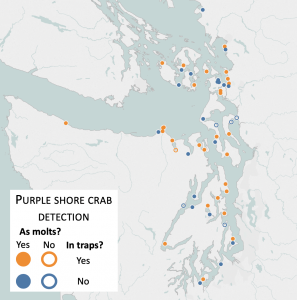
Map of Crab Team sites and whether or not purple shore crabs are found there in traps or as molts. Click to enlarge.
Crab Team tracks crustaceans across a network of 56 sites both by setting traps and by hunting for the shells crabs shed as they grow (molts). A number of monitors at different sites have keenly observed they might find a lot of purple shore crab molts, but see few live individuals, or none at all, in their traps. Crab Team uses both of these survey techniques because they could be different ways we might detect European green crab if they were present, but they also give us slightly different information about the crabs living at a site. To be captured in a trap, a crab has to be attracted to bait in the first place. Meaning, if a crab isn’t hungry, or eats only seaweed, it’s not likely to come to our traps. Crabs also have to be close enough to actually smell the bait for traps to be effective, but molted shells can get washed in from other locations depending on the winds, tides and shoreline shapes. Molt surveys sample more species from the crustacean community than our traps, including species that might not be interested in coming to the bait (the vegetarians), and those that live too far to find it. We think this might be at least part of the explanation for why, in 2018, purple shore crabs were captured in traps at only 29 of the 54 sites Crab Team had that year, but were found as molts at 48 of those sites. Species like purple shore crabs probably live relatively close by, maybe just outside the lagoon being sampled, but don’t venture in to find the traps.
Size might also matter. The purple shore crab grows larger than the hairy, which is typically under 30 millimeters (1.2 inches) across the back shell. Just as trapping surveys make it more likely we will detect certain species of crabs (those attracted to bait), molt surveys make it more likely we will detect certain sizes of crabs —larger ones. This is what scientists call sampling “bias,” and the detection bias in our molt survey for larger crab shells probably happens for two reasons. First off, it’s just easier to find larger things. In fact, it can take practice and patience to develop a search image for the smaller molts. Some as small as beach hoppers show up in our surveys. Second, because they are typically thinner than large shells, smaller shells break down faster in the waves and weather. Taken together, these two factors probably cause larger crab species to be overrepresented in our molt surveys relative to their true abundance in the habitat, and certainly overrepresented relative to the traps.
While it’s critical for us to recognize how sampling techniques could favor some species, sizes or types of organism over others, it’s also important to acknowledge that no sampling technique is perfectly unbiased (the closest anyone has ever come is the fictional “tricorder” from Star Trek). Our job is to try to understand these biases, and make sure we take them into account when interpreting the data.
While, to many people, purple shore crabs might be indistinguishable from hairy shore crabs, the data Crab Team monitors are gathering shows how even apparently small differences between related species can result in substantial differences in distributions. This can occur by a process ecologists call “niche partitioning.” The basic idea is that a single species can evolutionarily diverge into two separate species if they adapt to survive in slightly different habitats, environmental conditions or ecological communities. By using different parts of the environment, they minimize the need to compete with each other. Within the Salish Sea, a diversity of shoreline habitats is one factor that enables a high diversity of local crabs as well.
–Emily Grason
**While we try to use open access sources as often as possible, some of the studies cited in this article are not open access. If you have any questions about any of the research cited here, please feel free to reach out to crabteam@uw.edu.
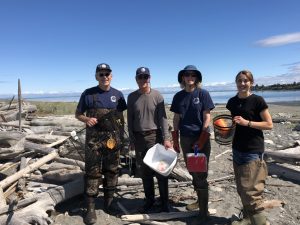
Volunteers Steve Cordz, Alan Smith, Laura Davis, and Lea Sollmann (L to R) at the spit. Photo courtesy of USFWS.
Dungeness Spit is well known as one of the most beautiful stretches of shoreline along the Strait of Juan de Fuca. Scenically capped by the New Dungeness Lighthouse, the spit wraps around Dungeness Bay, creating a protected haven along the relatively exposed beaches of the Strait and providing shelter and foraging ground for millions of shorebirds and migratory waterfowl each year.
In recent years, Dungeness Spit has also garnered attention due to the discovery of invasive European green crab. But since first being detected at the site in 2017, the community of people who treasure the beauty of the spit has banded together to put up a fierce resistance to the invasion. As Julianna Merluccio, a technician with U.S. Fish and Wildlife Service who oversees the trapping and removal effort at Dungeness National Wildlife Refuge, puts it:
“Although the refuge, the Makah, and the Salish Sea in general are unlucky in having European green crab, the crabs have luckily landed in areas with close-by land managers, and for us here, a huge group of very dedicated and committed citizens to back us up. For the effort on a whole, I think we can say it has been a saving grace.”
The “Other” Crabs at Dungeness Spit
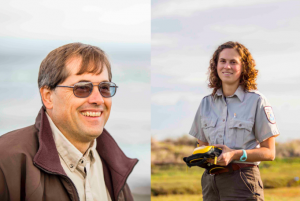
Lorenz Sollmann (L) and Julie Merluccio (R) – the U.S. Fish & Wildlife Service fearless leaders at Dungeness Spit. Photos courtesy of UW College of the Environment.
Situated on ancestral lands of the S’Klallam people, the Spit was designated a National Wildlife Refuge (NWR) in 1915, to be protected and preserved in support of wildlife. Part of that mission is prevention and management of invasive species that threaten the ecology of productive habitats like Dungeness Bay. The refuge began keeping an eye out for European green crab during the initial range expansion along the coast of Washington in the late 1990’s, actively setting traps to monitor for the first sign of an invasion into the Strait of Juan De Fuca. Dungeness NWR was one of only two or three programs in Washington that continued to monitor following the closure of a previous early detection effort in 2010, but never turned up any evidence of green crab.
When Crab Team was reinitiating early detection monitoring in 2015, we reached out to Lorenz Sollmann, Deputy Project Lead at the refuge, who had been working with NWR volunteers to trap for green crab. Sollmann collaborated with Crab Team staff to move monitoring sites on the refuge to better habitat for green crab, and align protocols to leverage the growing early detection network. In April 2017, Emily Grason, Crab Team program manager, traveled out to the spit to set traps at two new sites: one a shallow lagoon on the east side of Graveyard Spit (a pendulous peninsula on the northern end of Dungeness Spit), and the other a marsh channel just to the west. The next day, when Sollmann checked the traps, four green crab were found in the marsh channel — sounding the first alarm of a possible infestation (read more: https://wsg.washington.edu/egc-dungeness-press-release/).
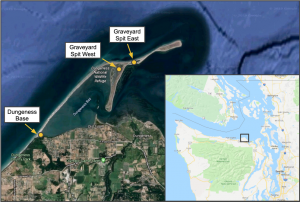
Map of the three sites monitored by the USFWS team, Dungeness Base, Graveyard Spit West, and Graveyard Spit East. Click to enlarge.
USFWS subsequently launched an aggressive removal-trapping campaign, setting about 50 traps for three or four nights most weeks from April through October each year. Because traps don’t capture every crab in the habitat each time they are set, a sustained effort is required to reduce the population and contain the invasion. USFWS primarily sets traps to target green crab hotspots, sections of habitat where they are most numerous, but also continues to explore other parts of the shoreline where they could also be hiding out. So far, green crab have primarily been captured in the channel at Graveyard Spit, and a few have also been found in a small lagoon at the base of Dungeness Spit (one crab was captured at a Crab Team site at Dungeness Landing, outside the refuge, but within Dungeness Bay: https://wsg.washington.edu/egc-status-update-june-2018/). To date, 222 European green crabs total have been captured within the NWR. This sounds like a lot of crabs, but it has taken more than 8,800 trap sets to capture that many.
Heroes of the Spit
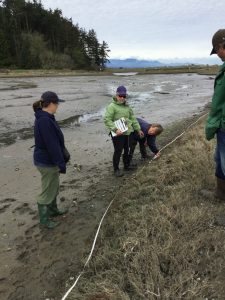
Volunteers Carol Jacobs, Kathy Anderson, Janet Bruening, and Mike Barton conducting a shoreline survey. Photo courtesy of USFWS.
It’s not just thousands of trap sets that can make management at Dungeness Spit NWR sound daunting. Graveyard Spit, the focus of trapping activity, is a three mile trek from refuge offices, and it’s only logistically practical to ferry people and gear back and forth by UTV (utility task vehicle) on sufficiently low tides. This is where the heroes of the spit come in. A group of about 30 USFWS volunteers have been specially trained to participate in green crab removal trapping efforts, and a core bunch of about a dozen participate in most of the trapping activities. Together, these dedicated defenders of Dungeness have spent more than 230 days out on the spit since 2017. This season alone, they contributed more than 1,000 volunteer hours to finding and removing green crab, which is about seven times the number of hours that USFWS staff have been able to commit to the effort, given all the other work that also needs to continue at Dungeness Refuge and the five others managed by the same office. So, it’s no stretch to say that without the participation and support of the dedicated USFWS volunteers, the spit, and the Salish Sea, would stand less of a chance against green crab.
Being part of the refuge system has been an asset to the effort to control green crab, but not without additional complications. On one hand, management staff and resources can be dedicated to the protection of Dungeness Spit, and that can streamline the logistics of doing control work. But at the refuge, careful considerations must be taken to ensure that the activities of the trappers don’t cause damage to the habitats and wildlife they are trying to protect. This often means that the job of the volunteers is harder than it otherwise might be. For instance, creating paths through the beach logs would make it easier to hike back and forth to the sites. But trappers at Dungeness Spit have to forego that convenience in order to avoid disturbing wildlife and natural processes that make the place so special.
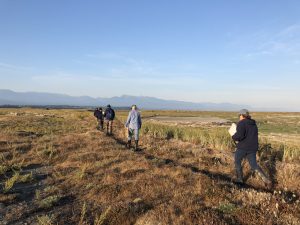
Volunteers Bob Anundson, Janet Bruening, Doug Marcoux, Pat Schoen, and Sue Bonomo. Photo courtesy of USFWS.
It’s difficult to underscore the commitment of the volunteers, some of whom have been a part of the project since before green crab were detected at the site. Work to control green crab is strenuous, dirty and often repetitive, yet the volunteers recognize the importance of tackling green crab as a team in an effort to protect the place they love. Rick Mazotta has cut 98% of the hundreds of pounds of bait required for trapping, Karl Pohld single-handedly keeps all the traps in good working condition, a half dozen UTV drivers take extra training to carry everyone safely to the sites, and, of course, the whole crew wakes up early, regardless of weather, to slog doggedly through the mud, carrying traps and bait, and enduring the pinches of crabs. Getting chauffeured down the spit in the UTV might seem luxurious, but trapping for green crabs is not a walk on the beach at Dungeness and the volunteers are a tough bunch!
The crew is masterful at multitasking. Crab-related work includes both monthly monitoring (á la Crab Team) as well as additional removal trapping, juggling two separate protocols and sets of gear at the same time. And it’s not just crabs! Because access to the spit is limited by tides and resources, volunteers are often concurrently conducting surveys for COASST (another citizen science project), running various errands for the refuge, and addressing any beach debris that needs to be removed. They also serve as ambassadors for the refuge, answering questions and offering assistance to visitors. When asked why they continue to participate, volunteers focus on the positives: curbing the invasion, protecting the refuge, learning more about pocket estuaries and salt marshes, the camaraderie of the other volunteers, and getting to experience “Wild Kingdom moments” — like river otters teasing bald eagles — first hand.
An Opportunity to Learn
The number of green crab captured at Dungeness Spit is greater than any other spot along the inland shorelines of Washington. This offers a unique opportunity to learn a great deal about the green crab invasion and how to manage it, information that could be invaluable as the Salish Sea braces to defend against the emerging threat of green crab. At most of the other detection locations only a handful of crabs have ever been captured, making it difficult to learn much about the invasion as a whole. Therefore, it’s important to glean as much as possible from sites like Makah Bay and Dungeness Spit, where intensive management is ongoing, and more crabs are being captured.
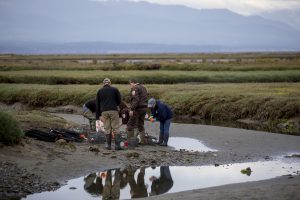
Julie Merluccio, Lorenz Sollman, Sue Bonomo and UW Staff checking traps on the spit. Photo courtesy of UW College of the Environment.
For instance, tissue samples collected from crabs captured in 2017 and analyzed by Crab Team collaborator Carolyn Tepolt, at Woods Hole Oceanographic Institution, enabled her to discern that green crabs at Dungeness Spit were not being washed in as larvae from Sooke Basin, just across the Strait. Rather, the larvae that reached Dungeness Spit came from one of the populations on the outer coast, though those populations are so genetically similar to each other, it’s not possible to tell which. (more info: https://wsg.washington.edu/crab-team-ssec18-pt1/). Friends of Dungeness National Wildlife Refuge also provided seed funding for that research. In addition, from the size of the green crabs captured at Dungeness Spit, we can tell that there is not much influx of young crabs, which could be either washed in (anew) from a coastal population, or the result of local reproduction. This is good news. The hope is that ongoing trapping will help trap down the surviving crabs that have washed into the bay in the past, and significantly reduce the chance of spread, and future recolonization will be less likely. The removal trapping efforts at Dungeness Spit have been ongoing for three years, enabling us to identify seasonal trends in how many crabs are captured. Each of the three years, the rate at which green crabs enter traps has peaked in late April and early May, which could signal that that is a good time of year to efficiently remove crabs from the habitat.
Not least of all, it’s extremely valuable that the staff and volunteers continue to participate in Crab Team monitoring in addition to all of the removal trapping work that they do. The trapping, molt hunt and shoreline survey protocols implemented monthly across all 56 Crab Team network sites were designed not only for early detection of European green crab, but also to track their impacts and associations. USFWS staff and volunteers now maintain three Crab Team monitoring sites, and green crab have been detected at two of them. Tracking sites with and without green crab over time is the highest standard of study design to learn about invasions. Making comparisons even just across the sites near Dungeness Bay will help us understand what factors drive green crab success, and what changes to the habitat green crab could be causing, even as volunteers are working to remove as many as possible. Several of the USFWS volunteers that contribute their time at Dungeness Spit also volunteer with Crab Team monitoring sites off-refuge.
A Relatively Cool Hotspot
Even though Dungeness Spit might be considered a green crab “hotspot” along Washington’s inland shorelines, it’s important to note that, overall, numbers are relatively low compared to places where green crab are established on the coasts of California, Oregon and British Columbia. On average, it takes about 100 traps to capture only two or three crabs, while some coastal sites can have tens or hundreds of times more crabs. While such a low capture rate would be very disappointing if you were trying to catch Dungeness crabs for your dinner, the numbers are actually a relief in terms of management. And, perhaps more importantly, they haven’t increased over the three years USFWS has been working to remove them. In other parts of the world where green crab have become invasive, their populations have increased rapidly to an unmanageable number. Avoiding that at Dungeness Spit, at least thus far, is itself a victory.
Green crab management at Dungeness Spit represents a robust collaboration between WSG Crab Team and the refuge, tracking two simultaneous and complementary efforts critical to effectively defending the Salish Sea against green crab. Consistently-implemented early detection monitoring in the form of Crab Team protocols provides information about the extent and progress of the invasion, but the trapping protocol is not enough to reduce a population. The additional intensive removal by USFWS staff and volunteers is necessary to intervene and actually try to stop establishment and spread of the crabs. At the core of both efforts are the generosity and dedication of volunteers, which might just be our greatest assets in the challenge of preventing a green crab invasion.
-Emily Grason
Photo Gallery
We love to get the virtual experience of monitoring with all of the Crab Team volunteers. Do you have a photo to share? Send it to crabteam@uw.edu. (Click on arrows to scroll, and photos to enlarge for more detail.)
